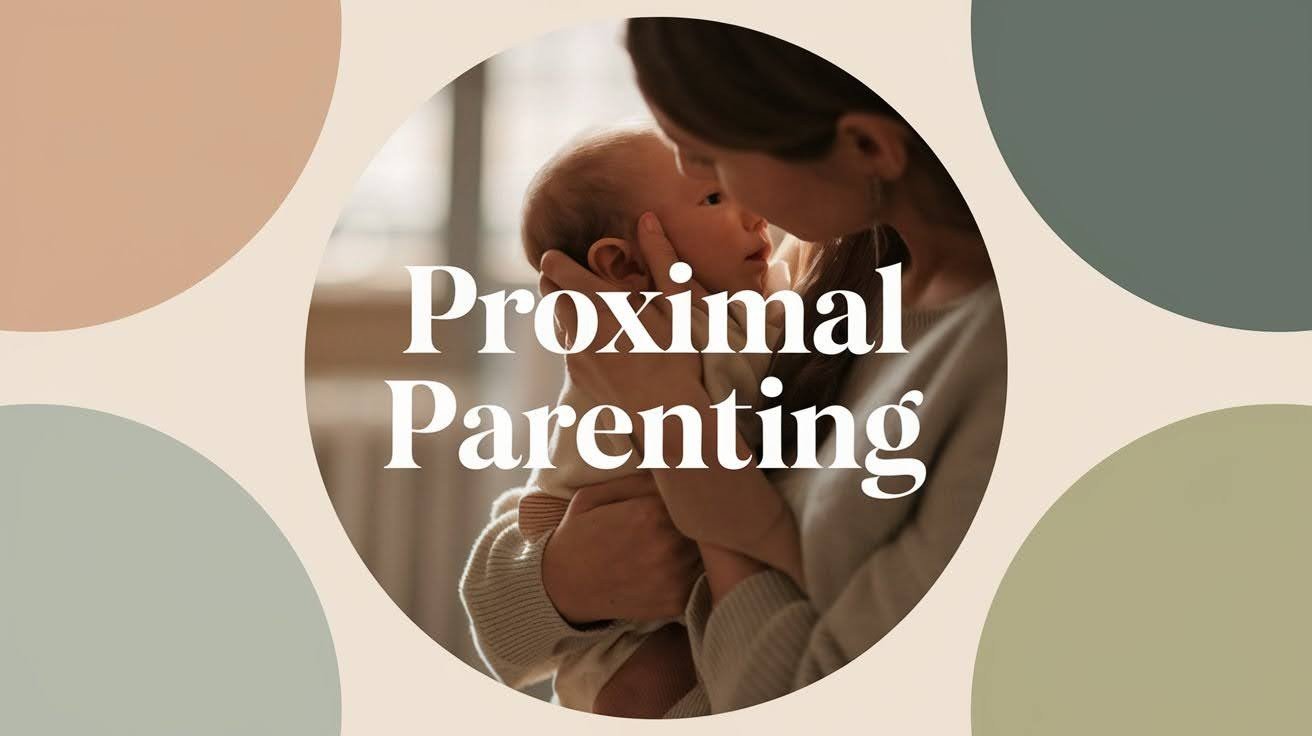Have you ever watched your mother carry her baby close to her chest, wondering if this kind of contact helps or hurts? This scene shows proximal parenting in action, a style that puts physical closeness at the center of raising children.
Proximal Parenting Focus on keeping babies and young children close through holding, co-parenting, breastfeeding, and constant touch. The words come from the”proximity” approach often appears in rural and farming communities where families work together closely.
This style differs greatly from distal parenting, which values independence, face-to-face talks, and using toys to help children learn. Proximal parenting builds the foundation for emotional, physical, and social growth through closeness and quick responses to a child’s needs.
What is Proximal Parenting?
Proximal parenting is a caregiving style that emphasizes physical closeness, responsiveness, and attunement to a child’s immediate needs. It often includes practices such as babywearing, co-sleeping, extended breastfeeding, and maintaining consistent caregiver presence.
The goal is to foster secure attachment by responding quickly and warmly to a child’s signals, especially during early development.
Unlike parenting approaches that prioritize independence early, proximal parenting builds confidence through closeness first, allowing independence to grow naturally when the child feels secure.
Key Cultural Contexts
Proximal parenting is deeply shaped by cultural values:
- Collectivist Societies (e.g., Africa, Asia, Indigenous communities): Proximal parenting is the norm, with extended family networks supporting co-sleeping, constant carrying, and community caregiving. Physical closeness is seen as essential for raising socially connected, emotionally secure children.
- Western Individualistic Cultures (e.g., U.S., Europe): Distal parenting is more common, emphasizing early independence, structured routines, and self-soothing. Practices like separate sleeping arrangements or scheduled feeding contrast with the responsiveness of proximal parenting.
- Cross-Cultural Insights: Research shows that neither approach is inherently “better.” Children raised in proximal cultures often develop strong social bonds, while those in distal cultures may excel in early self-reliance. However, secure attachment is more than a method that matters most.
Why This Matters for Parents?
Understanding the difference between proximal and distal parenting is important for families who want to make thoughtful choices about raising their children. Each approach offers its own benefits depending on the stage of development and family goals.
Some parents may even choose to blend both methods, providing closeness and physical contact during infancy, then gradually encouraging independence as their children grow. This balance can help meet both emotional security and autonomy needs.
Ultimately, there is no single “right” style. The best approach depends on a family’s values, cultural background, and the unique personality and needs of the child.
Key Characteristics of Proximal Parenting
Parents who use proximal parenting share several common practices that keep children physically and emotionally close:
Constant Physical Contact
Babywearing, co-sleeping, and extended breastfeeding form the core of this approach. Parents carry babies in slings or wraps throughout the day, keeping them close during work and daily tasks.
Co-sleeping means babies and young children share sleeping spaces with parents. This practice helps regulate the child’s body temperature, breathing, and sleep patterns through the parent’s presence.
Mother as Central Figure
The primary caregiver, usually the mother, becomes the main source of comfort and care. This person stays close to the child most of the time and responds quickly to all needs.
Other family members support the mother but don’t replace her central role. The child forms the strongest bond with this one person, creating a secure base for emotional growth.
Heightened Responsiveness
Parents watch for even small signs that their child needs something. They respond right away to crying, fussing, or other signals without waiting to see if the child can self-soothe.
This quick response builds trust between parent and child. The child learns that their needs will be met promptly, which helps them feel safe and secure in the world.
Core Differences Proximal Parenting:
| Aspect | Proximal Parenting |
| Physical Closeness | Maximum body contact through babywearing, co-sleeping, skin-to-skin contact, and constant physical proximity. Minimal use of equipment that separates the parent and child |
| Emotional Responsiveness | Immediate, highly sensitive responses to infant cues and signals. Continuous attunement to the child’s emotional and physical needs without delay |
| Feeding Practices | Exclusive on-demand breastfeeding for extended periods (often 2+ years). Child-led weaning and feeding rhythms based on natural hunger cues |
| Sleep Arrangements | Co-sleeping or bed-sharing to maintain nighttime closeness. Shared sleep spaces that facilitate easy nighttime caregiving and bonding |
| Independence Development | Gradual, secure-base driven independence. Children develop autonomy through consistent availability of caregiver support and emotional security |
| Communication Style | High levels of soothing vocalizations, gentle touch, and non-verbal communication. Emphasis on calming and comforting interactions |
| Cultural Context | Predominant in collectivist cultures, traditional societies, and communities emphasizing interdependence and family cohesion |
| Developmental Philosophy | The belief that early intensive caregiving creates a secure attachment foundation for later independence and emotional regulation |
Daily Integration
Children stay within arm’s reach during most daily activities. Parents hold babies on their laps during meals, carry them while doing chores, and keep them close during social visits.
Body warmth sharing happens naturally throughout the day. This closeness helps regulate the child’s stress levels and provides comfort during new or difficult situations.
Pros and Cons of Proximal Parenting
This approach offers both meaningful benefits and real challenges, so it’s important to see both sides before deciding if it’s right for your family.
| Pros of Proximal Parenting | Cons of Proximal Parenting |
|
|
|
|
|
|
|
|
|
|
Proximal Parenting Compared to Other Parenting Styles
Different parenting approaches work better for different families, and understanding how proximal parenting fits with other styles helps parents make informed choices:
Authoritarian Style
Authoritarian parenting focuses on strict rules and quick obedience, which conflicts with proximal parenting’s emphasis on warmth and responsiveness. These two approaches have very different views on parent-child relationships.
Authoritarian parents expect children to follow orders without question, while proximal parents focus on meeting emotional needs first. The closeness of proximal parenting doesn’t fit well with the distance that authoritarian parents often maintain.
Authoritative Style
Authoritative parenting shares proximal parenting’s focus on warmth and strong parent-child bonds. Both styles value responsive caregiving and meeting children’s emotional needs consistently.
The main difference comes in setting boundaries and encouraging independence. Authoritative parents balance closeness with clear limits, while proximal parenting may struggle with age-appropriate separation and rule-setting.
Permissive Style
Permissive parenting overlaps with proximal parenting in providing lots of nurturing and attention to children’s needs. Both styles prioritize the child’s comfort and happiness over strict rules.
However, permissive parenting can lead to spoiled behavior when combined with constant closeness. Children may learn that they can get whatever they want without learning proper boundaries or respect for others.
Conclusion
No single parenting approach works for every family, and proximal parenting offers valuable benefits through nurturing closeness while requiring balance with independence-building activities. The constant contact and quick responses help create secure, confident children when used thoughtfully.
Smart parents adapt and combine different approaches based on their family’s specific needs, their child’s personality, and their cultural background. The goal is to raise healthy, happy children who feel loved and supported while learning to handle age-appropriate challenges.
Proximal parenting works best when parents stay flexible and adjust their methods as children grow and change. By focusing on building strong relationships while gradually encouraging independence, families can enjoy the benefits of closeness without limiting their children’s development.
Frequently Asked Questions
At what age should I stop using proximal parenting methods?
There’s no strict age limit. Most families naturally reduce constant physical closeness between ages 3-5 as independence grows, while still nurturing emotional connection. The goal is to adapt, giving space while staying available and supportive.
Can proximal parenting work for working parents?
Yes, absolutely. Even with busy schedules, working parents can practice it through evening babywearing, co-sleeping, responsive caregiving, and meaningful rituals. Proximal parenting isn’t about constant presence it’s about creating reliable closeness whenever you are together, making children feel secure and valued.
Does proximal parenting make children too dependent?
No, when practiced mindfully, it fosters independence. Children raised with responsive care gain confidence through secure attachment, knowing support is available. Encouraging age-appropriate exploration alongside closeness helps kids grow resilient, self-assured, and able to balance connection with autonomy.
How does proximal parenting affect sleep training?
Proximal parenting usually avoids “cry-it-out” approaches. Instead, parents rely on responsive nighttime care, co-sleeping, or gentle soothing methods. This builds trust and helps children gradually form healthy sleep patterns, knowing their emotional and physical needs are met consistently and lovingly.
Can fathers practice proximal parenting too?
Definitely. Fathers can bond deeply through babywearing, skin-to-skin contact, co-sleeping, and being highly responsive. While breastfeeding may make mothers central early on, fathers’ active involvement ensures balanced attachment, helping children feel secure with both parents in nurturing, connected ways.








